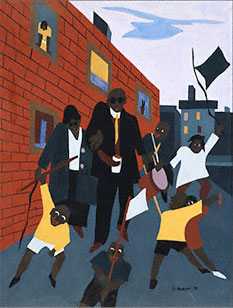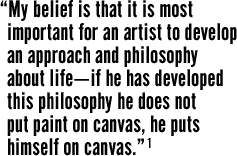




 |
 |
 |
 |
 |
||
 |
 Beggar No. 1 [Aka "Blind Beggars"], 1938 Tempera on Composition Board, 20 x 15 in. (50.8 x 38.1 cm) The Metropolitan Museum of Art. Gift of New York City W.P.A., 1943, 43.47.28 |
||||
| Over a sixty-five year
career, Jacob Lawrence (1917-2000) was an impassioned observer and storyteller
whose art documented both the African American experience as well as the
larger human struggle for freedom and social justice. In his gouache and
tempera compositions, he encapsulated the life around him: the joy, the
suffering, the weakness, and the strength of the people he saw every day.
Using bold, dynamic patterning, unusual angels of vision, and sophisticated
color juxtapositions he created socially conscious art free of sentimentality
and caricature. While based on his own experiences as an African American,
his art portrays the universal quest for freedom, social justice and human
dignity. For him, as he remarked in 1969, the struggle of African Americans
is part of the larger "struggle of man always to better his conditions
and to move forward."The exhibition, "Over the Line: The Art and
Life of Jacob Lawrence," brings together more than two hundred paintings
and drawings, representing Lawrence's most recognized themes and working
methods. Many of the paintings on view offer detailed pictorial accounts of the sidewalks, streets, brothels, and pool halls of Harlem. Lawrence recorded the raucous vitality as well as the unsavory details of Harlem social life. Drawing on the language of pattern, repetition, and rhythm, he brought attention to Harlem subjects that had hitherto been reserved for poets, writers, and photographers. Lawrence effectively translated to an audience outside Harlem the compelling cadences and explosive movements of life above 125th Street. Lawrence’s mastery of abstract compositional rhythms would become the hallmark of his mature art. The most characteristic feature of Lawrence’s earliest work was his use of multiple panels, each accompanied by a narrative caption. His earliest narratives focused on individual African American heroes and heroines: Frederick Douglass, John Brown, and Harriet Tubman, and the Haitian slave turned revolutionary Toussaint L’Ouverture. In 1940, he turned from individual sagas to a collective one, the Migration of the Negro, telling the story in 60 panels of the Great Migration of African Americans from the South to the North from 1916 through the twenties. As in his previous series, Lawrence adopted the tempo and pulse of folktales to create a visual analogue to the African American oral tradition. |
 The fourteen panels that constitute the War series differ from his earlier historic cycles in relying solely on images rather than on the conjunction of words and text. The result is less a narrative cycle than a sequence of self-contained canvases bound together by mood and subject. This technique of working on a cycle of paintings related to a single theme would henceforth become Lawrence’s favored format. Lawrence produced eleven paintings during a nine-month stay in 1949 at the Hillside Hospital, an institution for psychiatric treatment in Queens. They offer penetrating insight into the circumstances of mental illness and therapy, from the patients’ absorption in the occupational therapies of weaving and gardening to the listlessness of the depressed. During the 1950s, notwithstanding the rise of Abstract Expressionism and its rejection of recognizable imagery, Lawrence’s work remained figural. He turned, however, to increasingly edgy, fractured geometries and surrealist inversions of scale in compositions that skirt the edge of abstraction. His paintings on the theme of performer and the world of masks suggest his preoccupation with creative introspection, illusion, and the universality of performance, whether on stage or with a cue or cards. In 1964, he sold his apartment in New York and moved to Lagos, Nigeria. The works he produced during his eight-month stay there contain a new decorative freedom and panoramic liveliness. Lawrence retained this more decorative mode after his return to the United States, but shifted his subject matter. He began a series of paintings on the theme of the builder, many of which include African and Caucasian Americans working together. Emerging from his positive views of the human condition and the power of the human spirit to overcome obstacles, the subject symbolized, as he said, "man’s aspiration, as a constructive tool--man building." This theme continued in his work until the end of his career. |
||||
This exhibition has been organized by The Phillips Collection, Washington, D.C. The national tour of this exhibition was made possible by ExxonMobil. Additional support was provided by AT&T. This exhibition was also supported in part by a grant from the National Endowment for the Arts, a federal agency. The presentation of this exhibition at the Whitney is sponsored by HSBC Bank USA  Additional New York support is provided by AT&T and the Chairmanís Council of the Whitney Museum |
|||||
1. Ellen Harkins Wheat, Jacob Lawrence: American Painter , Seattle: University of Washington Press in association with the Seattle Art Museum, 1986, p. 73. Jacob Lawrence to Josef Albers, 1946. Black Mountain College Records, Faculty Files, 1946, Microfilm Roll 199, Archives of American Art, Washington, D.C. |
|||||
©2002 Whitney Museum of American Art |